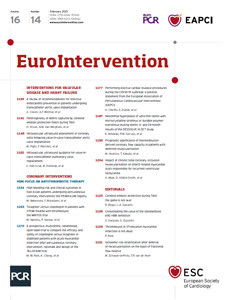
Abstract
Aims: The aim of this study was to determine whether revascularisation of an infarct-related artery chronic total occlusion (IRA-CTO) has a modulatory effect on myocardial scar composition.
Methods and results: This is a unique, first-time report of three consecutive patients presenting with myocardial scar-related recurrent ventricular tachycardia (rVT) on a background of ischaemic cardiomyopathy. Electro-anatomic mapping of the left ventricular endocardium was performed before and immediately after IRA-CTO percutaneous coronary intervention (PCI) to assess for changes in scar composition and size. There were substantial percentage reductions in the low voltage area of scar compared to baseline after IRA-CTO PCI (Patient 1: −12.8%, Patient 2: −27.0%, and Patient 3: −15.3%). Interval remapping ≥6 months after the index procedure demonstrated extensive net reductions in all areas of myocardial scar (Patient 1: dense scar =−7.5%, border zone scar =−54.9%, low voltage area =−32.7%, and Patient 2: dense scar =−38.6%, border zone scar =−59.6%, low voltage area =−51.7%). Patient 3 declined interval remapping but has remained free of rVT at one-year follow-up.
Conclusions: IRA-CTO PCI may positively modify the size and composition of myocardial scar associated with rVT in the context of ischaemic cardiomyopathy.
Introduction
Coronary chronic total occlusions (CTO) confer a higher than normal risk of ventricular arrhythmia (VA) and mortality1. Studies also suggest that a chronic occlusion of an infarct-related coronary artery (IRA-CTO) is an independent predictor of recurrent ventricular tachycardia (rVT) despite previously successful radiofrequency ablation (RFA)2. Whether revascularisation of an IRA-CTO in patients with ischaemic cardiomyopathy complicated by rVT has a modulatory effect on myocardial scar is unknown.
Methods
Three consecutive patients presented to our institution with rVT from November 2015 to July 2016. High-density multi-electrode electro-anatomic mapping (EAM) of the left ventricular endocardium was performed before and immediately after IRA-CTO revascularisation, using CARTO® 3 (Biosense Webster, Diamond Bar, CA, USA) or EnSite™ NavX™ Velocity™ (St. Jude Medical, St. Paul, MN, USA) mapping systems in conjunction with PentaRay® (Biosense Webster) or Livewire™ (St. Jude Medical) catheters. This was performed as a single procedure.
Following an interval of at least six months, patients were brought back for high-density scar remapping prior to planned VT ablation. All patients provided written informed consent for their procedures.
Results
A 60-year-old gentleman with ischaemic cardiomyopathy and an IRA-CTO of his right coronary artery (RCA) presented with rVT. He had had a successful VT ablation and an implantable cardioverter-defibrillator (ICD) in situ from four years previously. EAM revealed low voltage scar around the mid and basal aspects of the inferior wall consistent with previous myocardial infarction (MI) and ablation (Supplementary Figure 1). Immediately after RCA CTO percutaneous coronary intervention (PCI) (Supplementary Figure 2), remapping revealed extensive changes in the composition and dimensions of the myocardial scar. After a six-month interval, remapping revealed further changes in scar characteristics (Supplementary Table 1). The patient has remained free of significant VT after repeat RFA at one-year follow-up.
A 77-year-old gentleman with ischaemic cardiomyopathy presented with rVT. Angiography revealed a left anterior descending (LAD) artery CTO. EAM revealed low voltage scar around the apex, anterior and anteroseptal walls, consistent with a previous anterior infarct. The patient proceeded to LAD CTO PCI. Immediate remapping thereafter revealed a substantial reduction in both the low voltage and border zone areas, but no change in the dense scar area. After an eighteen-month interval, EAM revealed considerable net reductions in all areas of scar.
A 56-year-old gentleman presented with rVT. He had had a lateral MI fifteen years previously associated with an atrioventricular circumflex (AVCx) artery CTO. Cardiac magnetic resonance imaging demonstrated severely impaired left ventricular systolic function and a thin, akinetic lateral wall with evidence of viability in the anterior and inferior walls. EAM revealed low voltage scar around the lateral and posterior wall. AVCx CTO PCI was performed during the index admission. Immediate remapping thereafter showed reductions in all zones of the infarct territory. The patient declined the offer of interval remapping prior to VT RFA. He has remained in New York Heart Association Class II with no further admissions for rVT.
Discussion
For the first time in the literature, IRA-CTO PCI has been shown to induce an immediate reduction in the low voltage area of an infarct territory on EAM, followed by a further reduction after an intervening period. There were also substantial reductions to the border zone and dense scar areas in the two patients who had interval remapping at ≥6 months prior to planned VT RFA.
A putative mechanism for the increased susceptibility to VA in post-MI scar is ischaemia. Chronic hypoperfusion circumventing the infarcted necrotic core may adversely impact on the border zone by increasing regions of slow conduction, which provide substrate for re-entry. Revascularisation of an IRA-CTO may potentially lead to improved perfusion of the infarcted region, thereby reducing ischaemic burden and the extent of the border zone area.
This novel observation could have wide-ranging implications for the management of scar-related rVT. Rather than consider revascularisation of an IRA-CTO based purely on viability and the abolition of angina symptoms, our observations suggest that there is scope to perform PCI in this lesion subset as a means of attenuating arrhythmogenic substrate. Furthermore, IRA-CTO PCI could revolutionise the timing and efficacy of VT RFA. Performing VT RFA in those with ischaemic cardiomyopathy and an ICD has been shown to lower the rate of the composite primary outcome of death, VT storm and appropriate ICD therapy significantly when compared to escalation of anti-arrhythmic therapy alone, especially when the patient has already been treated with amiodarone. Eradication of all induced VTs during an ablation can, however, be a long and difficult procedure. In performing PCI for this subset of patients with an IRA-CTO to reduce the border zone area first, we may potentially streamline and enhance the success of subsequent VT RFA by allowing for more targeted ablation.
Limitations
This is a small study so robust conclusions cannot be drawn. Moreover, the use of different mapping systems may have affected the continuity of the results. There is much to learn here and we accept that these observations could simply be a play of chance, hence the need for a prospective proof-of-concept study to understand better the effects of IRA-CTO revascularisation on scar-related VT substrate, its role in the long-term management of rVT, alongside hospital re-admission rates for VT and the burden of VT as assessed by ICD discharge and antitachycardia pacing volume.
Conclusions
Percutaneous revascularisation of an IRA-CTO may positively modify the size and composition of myocardial scar responsible for rVT, signalling a potentially novel indication for CTO PCI in a subset of patients with ischaemic cardiomyopathy.
|
Impact on daily practice IRA-CTO PCI may reduce the size and composition of myocardial scar in a subset of patients with ischaemic cardiomyopathy presenting with rVT. Further investigation is required but we suggest that this observation could represent a novel and innovative indication for CTO PCI over and above the established need to mitigate angina symptoms when viability is demonstrated. IRA-CTO PCI could be performed as an adjunct to scar-mediated VT ablation to reduce ICD discharge and recurrent hospitalisation, and to help moderate the use of anti-arrhythmic pharmacotherapy. |
Conflict of interest statement
J. Silberbauer reports receiving speaker’s fees from St. Jude, Biosense Webster and Bayer. The other authors have no conflicts of interest to declare.
Supplementary data
To read the full content of this article, please download the PDF.

